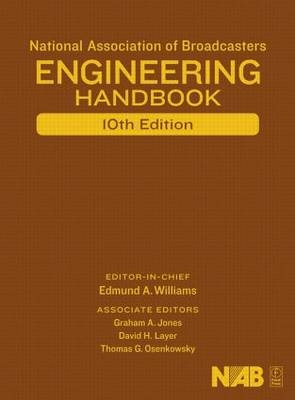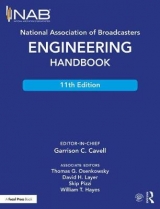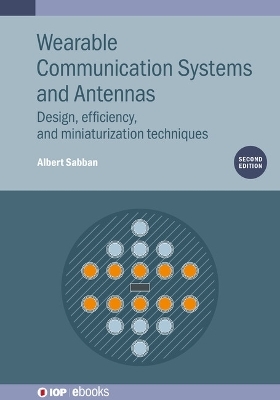
National Association of Broadcasters Engineering Handbook
Focal Press (Verlag)
978-0-240-80751-5 (ISBN)
- Titel erscheint in neuer Auflage
- Artikel merken
The NAB Engineering Handbook provides detailed information on virtually every aspect of the broadcast chain, from news gathering, program production and postproduction through master control and distribution links to transmission, antennas, RF propagation, cable and satellite. Hot topics covered include HD Radio, HDTV, 2 GHz broadcast auxiliary services, EAS, workflow, metadata, digital asset management, advanced video and audio compression, audio and video over IP, and Internet broadcasting. A wide range of related topics that engineers and managers need to understand are also covered, including broadcast administration, FCC practices, technical standards, security, safety, disaster planning, facility planning, project management, and engineering management.
Basic principles and the latest technologies and issues are all addressed by respected professionals with first-hand experience in the broadcast industry and manufacturing. This edition has been fully revised and updated, with 104 chapters and over 2000 pages. The Engineering Handbook provides the single most comprehensive and accessible resource available for engineers and others working in production, postproduction, networks, local stations, equipment manufacturing or any of the associated areas of radio and television.
Graham Jones has more than 35 years experience in the broadcast industry. With NAB he works on advanced television issues, technical standards, education and training. He is a member of both ATSC and SMPTE engineering committees. Previously he was Engineering Director for the Harris/PBS DTV Express - the educational road show that introduced DTV to many U.S. broadcasters. He started his career with the BBC in London, and has worked as a consultant to broadcasters in many parts of the world. He holds a degree in physics, is a chartered electrical engineer, and is a member of the IEE, SMPTE, SBE and the Royal Television Society. In 2004 he received the Bernard J. Lechner Outstanding Contributor Award from the Advanced Television Systems Committee. David Layer is Director, Advanced Engineering in the Science & Technology Department of NAB, located in Washington, DC. David has been with NAB since 1995, and has been very active in the radio standards setting area. He is also involved in NAB's technical conference planning and technical publication activities, and has been an author and contributing author for numerous technical publications, including IEEE Spectrum magazine (a leading journal of the Electrical Engineering profession) and the McGraw-Hill Yearbook of Science and Technology. Tom Osenkowsky is a Senior Member of IEEE, NARTE and SBE. He has been practicing broadcast engineering since 1976. He has designed, constructed and maintained radio broadcast facilities in the United States and Caribbean Islands, written software for engineering applications and is a freqquent contributor to Radio World magazine.
1.Broadcast Standards and Practices
1.1 Electromagnetic Spectrum
1.2 Frequency Allocations for Broadcast Services
1.3 FCC Organization and Administrative Practices
1.4 FCC Compliance and Information Bureau
1.5 Frequency Coordination
1.6 Distance and Bearing Calculations
1.7 Broadcast Standards and Practices
1.8 Digital Audio Standards
1.9 NTSC Standard
1.10 Worldwide Standards for Conventional Television
1.11 EAS
2.Broadcast Towers and Systems
2.1 Propagation Characteristics
2.2 Design, Erection, and Maintenance of Towers
2.3 Lightning Protection for Tower Structures
2.4 Coaxial Transmission Line
3.Audio Production Facilities
3.1 Planning an Audio Production Center
3.2 Principles of Acoustics
3.3 Microphones
3.4 Audio Recording Systems
3.5 Studio Audio Equipment
3.6 Station Networking and Automation
3.7 Digital Audio Data Compression Technologies
3.8 Transmission Audio Processing
3.9 Remote News and Production
3.10 Telephone Network Interfacing
3.11 Common Carrier Audio Program Services
4.Radio Transmission Facilities
4.1 AM Transmitters
4.2 AM Stereo
4.3 FM Transmitters
4.4 FM Stereo and SCA Systems
4.5 STL Systems
4.6 Radio Data Broadcasting
4.7 AM IBOC System
4.8 FM IBOC System
4.9 Transmission System Control and Monitoring
4.10 AM Antenna Systems
4.11 AM Antenna Coupling and Phasing Systems
4.12 Computer Simulation of Radio Antenna Systems
4.13 AM Antenna System Maintenance
4.14 FM Broadcast Antennas
4.15 FM Combining Systems
4.16 FM Translators and Boosters
4.17 AM and FM Field Strength Measurements
5.Video Production Facilities
5.1. Planning a Video Production Center
5.2. Principles of Light, Vision, and Photometry
5.3. Video Pickup Devices and Systems
5.4. Video Signal Switching, Timing, and Distribution
5.5. Magnetic and Optical Recording Media
5.6. Video Compression
5.7. Video Recording Principles
5.8. Video Server Storage Systems
5.9. Video Special Effects Systems
5.10. Station Automation and Networking
5.11. Intercom and IFB Systems
5.12. Weather Radar Systems
5.13. Closed Captioning and Extended Services
5.14. Film for Television
5.15. Television Camera Robotics
5.16. Lighting for Television
5.17. Remote Video Production
6.Television Transmission Facilities
6.1 Microwave and STL Systems
6.2 Television Transmitters
6.3 Multichannel Television Sound
6.4 Television Data Broadcasting Systems
6.5 Transmission System Control and Monitoring
6.6 Waveguide
6.7 Diplexers, Combiners, and Filters
6.8 Television Antenna Systems
6.9 Television Field Strength Measurement
6.10 Fiber Optic Transmission Systems
6.11 Satellite Earth Stations and Systems
6.12 Low Power Television
7.Digital Television
7.1. The ATSC DTV System
7.2. Service Multiplex and Transport Systems
7.3. Audio Encoding and Decoding
7.4. Program and System Information Protocol
7.5. Closed Captioning
7.6. Data Broadcasting
7.7. Media and Metadata Management
7.8. Interactive Television
7.9. The DVB Standard
8.Signal Measurement and Testing
8.1. Audio Signal Analysis
8.2. Video Signal Analysis
8.3. Radio Frequency Signal Analysis
9.Ancillary Broadcast Systems
9.1 Broadcast Facility Planning and Construction
9.2 AC Power Conditioning
9.3 Facility Grounding Practices
9.4 Standby Power Systems
10.Technical Management and Safety
10.1 Managing a Technical Facility
10.2 Engineering Documentation
10.3 Systems Engineering Concepts
10.4 Non-Ionizing Radiation
10.5 PCBs and Other Hazardous Substances
10.6 Electrical Shock
10.7 Tower Safety, Fall Arrest Systems, and OSHA
10.8 Disaster Planning and Recovery
10.Index
| Erscheint lt. Verlag | 3.7.2007 |
|---|---|
| Verlagsort | Oxford |
| Sprache | englisch |
| Maße | 219 x 276 mm |
| Gewicht | 3175 g |
| Themenwelt | Technik ► Nachrichtentechnik |
| ISBN-10 | 0-240-80751-0 / 0240807510 |
| ISBN-13 | 978-0-240-80751-5 / 9780240807515 |
| Zustand | Neuware |
| Haben Sie eine Frage zum Produkt? |
aus dem Bereich



